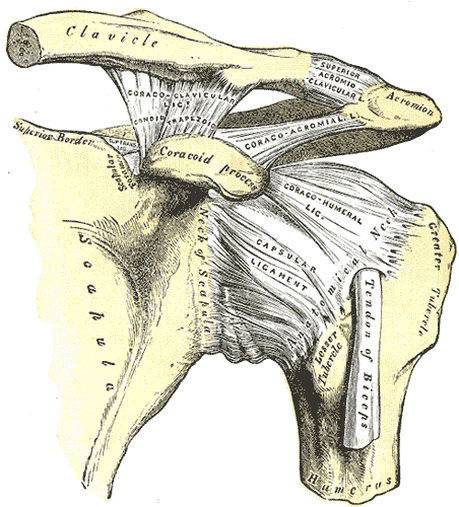We are going to cover a lot ground today, so strap yourself in and hang on! There are a wide variety of non-Rotator Cuff shoulder problems that always seem to be confused with each other. I see these three very different problems frequently misdiagnosed. Is the problem Bicep Tendinosis, Subacromial Bursitis, or Shoulder Impingement Syndrome? We will answer this question at the bottom of the page. Stick with me because you’ll need to first look at some pictures in order to follow.

A VIEW OF BOTH SHOULDERS WITH CERTAIN PARTS REMOVED

THE LIGAMENTS THAT MAKE UP THE JOINT CAPSULE OF THE LEFT SHOULDER. THE ANATOMICAL STRUCTURE ON THE TOP FAR-RIGHT IS THE ACROMION PROCESS. THE AREA JUST BELOW IT IS CALLED THE SUB-ACROMIAL SPACE.
YOU CAN SEE THE BICEPS TENDON

THE TWO HEADS OF THE BICEPS TENDON (LEFT SHOULDER) THE LONG HEAD (LATERAL) & SHORT HEAD (MEDIAL). ALTHOUGH THEY ARE DIFFICULT TO SEE, NOTE THE TWO BURSAE JUST ABOVE AND TO EITHER SIDE OF THE TOP OF THE BICEPS TENDON (LONG HEAD).

THIS PICTURE OF A RIGHT SHOULDER SHOWS THE LONG HEAD OF THE BICEPS TENDON AS WELL AS ONE OF THE MANY BURSAE (BLUE). NOTE THAT THE COLLAR BONE AND ACROMIAN ARE REMOVED IN THIS PICTURE.

IN THIS PICTURE OF A RIGHT SHOULDER, YOU CAN SEE THE SUPRASPINATUS TENDON AND THE LONG, FLAT BURSA IN THE SUB-ACROMIAL SPACE. YOU CAN ALSO SEE THE PROXIMITY OF THE BURSA TO THE TOP OF THE BICEPS TENDON. PAY ATTENTION TO THE AC (ACROMIOCLAVICULAR) JOINT AS WELL.

THE ROTATOR CUFF MUSCLES OF THE BACK SIDE OF THE LEFT ARM (PARTICULARLY THE SUPRASPINATUS MUSCLE AT THE VERY TOP) WITH THE CLAVICLE / ACROMION REMOVED.
Bursa or Bursae (plural) are fluid filled sacs that whose purpose is to reduce friction / wear by providing a barrier cushion between bones and tendons. Healthy bursae create an almost frictionless gliding surface for tendons that makes normal movement painless. Enter BURSITIS. The word “itis” means INFLAMMATION. When inflammation is seen in a bursa, the problem is referred to as “bursitis”. With bursitis, movement that occurs on the inflamed bursa becomes difficult and painful. This painful and restricted movement of muscle tendons over the inflamed bursa further aggravates the condition causing even more inflammation. Do you see a vicious cycle starting to spin?
Bursitis is usually caused by repetitive injury. In the case of the subacromial bursa (the bursa below the acromion), this is frequently due to repetitive micro-trauma to the SUPRASPINATUS TENDON. As the bursitis progresses, you see a proliferation of COLLAGEN FORMATION in the area. And unless specific steps are taken, this collagen will be laid down in a tangled, twisted, matted fashion (like a hairball) as opposed to a uniformly smooth fashion (well-combed hair). Furthermore, because Inflammation (a chemical problem) attracts fluid to it, you can often find increased fluid production and swelling inside the bursa, while seeing a decreased fluid production on the outside of the bursa. As you can imagine, this can dry out the joint.
The shoulder bursae allow for smooth motion of the Rotator Cuff underneath the arch made by the Acoromioclavicular (AC) joint (see second picture from the top). Any pressure on the anatomical structures under the arch (in the sub-acromial space) can lead to something called Shoulder Impingement Syndrome. Some of the causes of Shoulder Impingement Syndrome include…….
- SUPRASPINATUS TENDINOSIS:
- ROTATOR CUFF TENDINOSIS:
- SUBACROMIAL BURSITIS:
- Bone Spurs (DEGENERATION):
- Shoulder Instability (Previous Dislocations or Separations):
- Loss of Rotator Cuff Strength:
- RADICULITIS or Nerve Entrapment: (entrapment of the nerve, artery, or vein can also cause something called THORACIC OUTLET SYNDROME)
With both Shoulder Impingement Syndrome and BICEPS TENDINOSIS, the most common symptom is pain along the front of the shoulder. This pain is often associated with muscle weakness as well as lost range of motion in the shoulder. A Subacromial Bursitis causing Shoulder Impingement will often have lateral shoulder pain as well. The classic Orthopedic Test to determine whether or not someone has a subacromial bursitis is the Subacromial Push Button Sign. You simply push the area on the front of the arm / shoulder below the Acromion Process to see if a pain response can be elicited.
As you can imagine, this results of this test are fairly vague and do not provide a lot of valuable information. Neer’s Sign (pain in the front of the shoulder when it is raised straight up, directly out in front of you) is not very specific either. These tests tell you something is wrong with the shoulder, they are not very specific as to what that problem really is. Be aware that people with Shoulder Impingement Syndrome will usually have difficulty with overhead activities (throwing, swimming, overhead work, etc) and may find that their problem is actually worse at night.
Make sure you come back tomorrow to learn about the differences between a separated shoulder and a dislocated shoulder —- two totally different problems (HERE).
